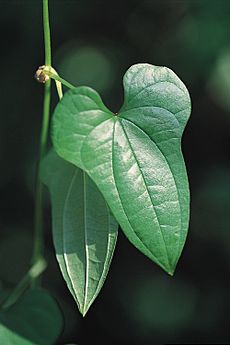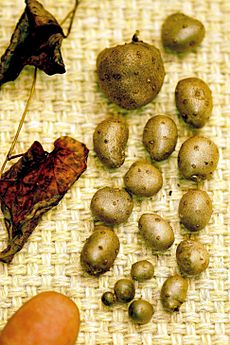Chinese yam facts for kids
Quick facts for kids Chinese yam |
|
|---|---|
 |
|
| Scientific classification | |
| Genus: |
Dioscorea
|
| Species: |
polystachya
|
| Synonyms | |
Dioscorea polystachya is a plant often called Chinese yam. It is also known as cinnamon-vine or Chinese potato. In Korea, it's called ma. This plant is part of the yam family.
It is a climbing plant that grows year after year. It comes from East Asia. Its edible tubers (the underground parts) are grown a lot in Asia. Sometimes, people use them in traditional medicine. This yam is special because you can eat its tubers raw. Most other yams need to be cooked first.
Contents
Where Chinese Yam Grows
This plant grows naturally across East Asia. It probably arrived in Japan around the 1600s or even earlier. In the 1800s, it was brought to the United States. People planted it for food and for its beauty. Now, it is seen as an invasive plant species in some areas.
The Chinese yam also came to Europe in the 1800s. This was during a time when potatoes were failing. Today, it is still grown in Europe for Asian food markets.
What Chinese Yam Looks Like
Chinese yam vines usually grow 3 to 5 meters long. They can even grow longer! The vines twist around things in a clockwise direction.
The leaves are about 11 centimeters long and wide. They have a special shape at the bottom. Larger leaves might have wavy edges. They can grow in different ways on the stem. Sometimes they are opposite each other, or they might be in groups.
Small, bumpy, round parts grow where the leaves meet the stem. These are called bulbils. They are less than 2 centimeters long. People sometimes call them "yam berries." New plants can grow from these bulbils.
The flowers of the Chinese yam smell like cinnamon.
This plant grows one or more long, thin tubers underground. The biggest ones can weigh 10 pounds! They can grow up to one meter deep. Chinese yam can handle cold weather better than other yams. This is why it has spread successfully to many parts of the world.
Different Names for Chinese Yam
In China, it is called shānyào (simplified Chinese: 山药; traditional Chinese: 山藥). Other names include huáishān (simplified Chinese: 怀山; traditional Chinese: 懷山) or huáishānyào (simplified Chinese: 怀山药; traditional Chinese: 懷山藥). The yam bulbils are called shanyao dou (simplified Chinese: 山药豆; traditional Chinese: 山藥豆).
In Japan, there are three main types of this yam:
- The common long one is called nagaimo (長芋).
- The flat, hand-shaped one is ichōimo (銀杏芋).
- The round one is tsukune imo (つくね芋).
Sometimes, the name yamatoimo (大和芋) is used. This can be confusing because it refers to different types depending on the region.
In Korea, it is called ma (Korean: 마). Other names include sanu (Korean: 산우; Hanja: 山芋) or sanyak (Korean: 산약; Hanja: 山藥).
In Sri Lanka, it is called wal ala (වැල් අල). In Vietnam, it is củ mài. In the Philippines, it is tuge. In Latin American countries, it is sometimes called white name or white ñame.
Chinese Yam in Traditional Medicine
Chinese yam, called Huáishān, has been used in traditional Chinese medicine for a long time. However, it's important to know that some products made from similar plants claim to have special health benefits. For example, some creams say they contain human hormones. But experts like the American Cancer Society say these claims are false. There is no proof that these products are safe or work well for serious health issues.
Chinese Yam as an Invasive Plant
Dioscorea polystachya was brought to the United States in the 1800s. People planted it as a pretty garden plant or for food. Now, it grows wild in many places. It causes problems in areas like Great Smoky Mountains National Park. It is spreading quickly there.
This yam can be hard to get rid of. Cutting the vines at ground level often makes the problem worse. This is because the plant can grow back from its strong tubers. There are special beetles that help control a similar plant called air potato in Florida. But these beetles are not available everywhere. Chinese yam grows best in wet places. It can also survive in colder areas, like as far north as New York.
How People Use Chinese Yam
The tubers of Chinese yam can be eaten raw. You can grate them or slice them. Most other yams must be cooked because they have harmful substances when raw.
First, you need to peel the skin off the yam. This might make your hands a little itchy. Wearing gloves is a good idea. If your hands do get itchy, lemon juice or vinegar can help.
After peeling, the whole tubers are soaked briefly in water with vinegar. This helps remove tiny crystals that can cause irritation. It also stops the yam from changing color. Raw yam is starchy and doesn't have a strong taste. It becomes a bit slimy when cut or grated. You can eat it plain as a side dish or add it to noodles.
Japanese Food
In Japanese cooking, Chinese yam and Japanese yam are used in similar ways. Chinese yam (nagaimo) is often more watery. The native Japanese yam is thicker.
A slimy puree called tororo is made by grating the yam. People often use a special bowl called a suribachi and a wooden tool to grind it.
Tororo is mixed with other things like tsuyu broth (made from soy sauce and dashi). Sometimes, wasabi or green onions are added. It is often eaten over rice or a mix of rice and barley.
If tororo is poured over sliced raw tuna, it's called yamakake. This is eaten with soy sauce and wasabi. You can also pour tororo over noodles like udon or soba.
Grated yam is also used to help bind ingredients together. For example, it's used in the batter for okonomiyaki, a savory pancake. It can also be used to make the skin of a sweet treat called manjū.
Chinese Food
In China, Chinese yam is called shānyào (simplified Chinese: 山药; traditional Chinese: 山藥). The tuber can be eaten raw, steamed, or deep-fried. It is added to savory soups. Sometimes, it is sweetened with a berry sauce.
Korean Food
In Korea, there are two main kinds of Chinese yam. The long, straight one is jangma (Korean: 장마). The shorter, cluster-like one is danma (Korean: 단마). Both are used in cooking.
They are often eaten raw. The peeled yam roots are blended with water, milk, or yogurt. Sometimes honey is added. This makes a healthy drink called majeup (마즙). You can also cut the peeled tubers into pieces. They can be served raw, cooked, steamed, or fried with sauces.
Growing Chinese Yam
Chinese yam takes about one year to grow. You should plant it between winter and spring. There are a few ways to grow it:
- Using smaller tubers.
- Using the top part of bigger tubers.
- Using cuttings from the branches.
The first two ways can grow tubers that are 20 centimeters (about 8 inches) long or more. Cuttings usually make smaller tubers (about 10 centimeters or 4 inches). These smaller ones are often replanted for the next year.
After 7 to 9 months, the leaves of the Chinese yam start to dry up. This is a sign that the tubers underground are ready to be harvested. In home gardens, people usually only dig up what they need to eat. The rest of the tubers can stay in the moist soil.





